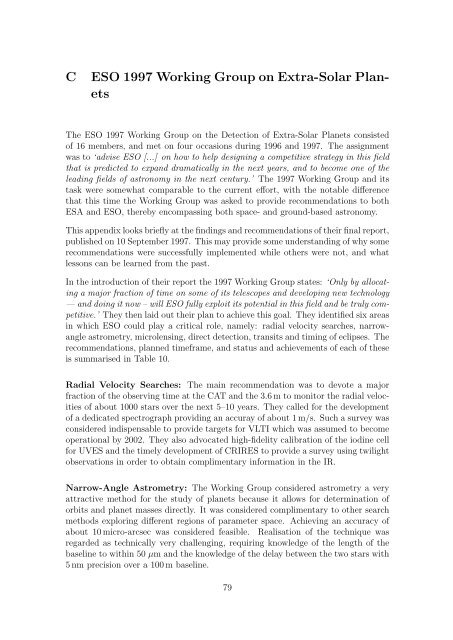Report - School of Physics
Report - School of Physics
Report - School of Physics
You also want an ePaper? Increase the reach of your titles
YUMPU automatically turns print PDFs into web optimized ePapers that Google loves.
C<br />
ESO 1997 Working Group on Extra-Solar Planets<br />
The ESO 1997 Working Group on the Detection <strong>of</strong> Extra-Solar Planets consisted<br />
<strong>of</strong> 16 members, and met on four occasions during 1996 and 1997. The assignment<br />
was to ‘advise ESO [...] on how to help designing a competitive strategy in this field<br />
that is predicted to expand dramatically in the next years, and to become one <strong>of</strong> the<br />
leading fields <strong>of</strong> astronomy in the next century.’ The 1997 Working Group and its<br />
task were somewhat comparable to the current effort, with the notable difference<br />
that this time the Working Group was asked to provide recommendations to both<br />
ESA and ESO, thereby encompassing both space- and ground-based astronomy.<br />
This appendix looks briefly at the findings and recommendations <strong>of</strong> their final report,<br />
published on 10 September 1997. This may provide some understanding <strong>of</strong> why some<br />
recommendations were successfully implemented while others were not, and what<br />
lessons can be learned from the past.<br />
In the introduction <strong>of</strong> their report the 1997 Working Group states: ‘Only by allocating<br />
a major fraction <strong>of</strong> time on some <strong>of</strong> its telescopes and developing new technology<br />
— and doing it now – will ESO fully exploit its potential in this field and be truly competitive.’<br />
They then laid out their plan to achieve this goal. They identified six areas<br />
in which ESO could play a critical role, namely: radial velocity searches, narrowangle<br />
astrometry, microlensing, direct detection, transits and timing <strong>of</strong> eclipses. The<br />
recommendations, planned timeframe, and status and achievements <strong>of</strong> each <strong>of</strong> these<br />
is summarised in Table 10.<br />
Radial Velocity Searches: The main recommendation was to devote a major<br />
fraction <strong>of</strong> the observing time at the CAT and the 3.6 m to monitor the radial velocities<br />
<strong>of</strong> about 1000 stars over the next 5–10 years. They called for the development<br />
<strong>of</strong> a dedicated spectrograph providing an accuray <strong>of</strong> about 1 m/s. Such a survey was<br />
considered indispensable to provide targets for VLTI which was assumed to become<br />
operational by 2002. They also advocated high-fidelity calibration <strong>of</strong> the iodine cell<br />
for UVES and the timely development <strong>of</strong> CRIRES to provide a survey using twilight<br />
observations in order to obtain complimentary information in the IR.<br />
Narrow-Angle Astrometry: The Working Group considered astrometry a very<br />
attractive method for the study <strong>of</strong> planets because it allows for determination <strong>of</strong><br />
orbits and planet masses directly. It was considered complimentary to other search<br />
methods exploring different regions <strong>of</strong> parameter space. Achieving an accuracy <strong>of</strong><br />
about 10 micro-arcsec was considered feasible. Realisation <strong>of</strong> the technique was<br />
regarded as technically very challenging, requiring knowledge <strong>of</strong> the length <strong>of</strong> the<br />
baseline to within 50 µm and the knowledge <strong>of</strong> the delay between the two stars with<br />
5 nm precision over a 100 m baseline.<br />
79
















